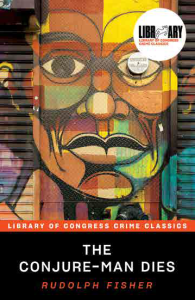 Rudolph Fisher’s The Conjure-Man Dies is an important piece of crime and mystery novel history. The tale itself is a splendid blend of drawing room mystery and look at the world of Harlem in the Great Depression, warts and all.
Rudolph Fisher’s The Conjure-Man Dies is an important piece of crime and mystery novel history. The tale itself is a splendid blend of drawing room mystery and look at the world of Harlem in the Great Depression, warts and all.
The book introduces us to Doctor John Archer, a tall, thin, well educated man with a more than passing resemblance to Sherlock Holmes. There is less than nothing wrong with that, though the juxtaposition with setting helps to make him seem all the more unusual. The fact that the deceased titular character bears an obvious resemblance to Holmes is rife with potential meanings in terms of story, particularly given the death of Sir Arthur Conan Doyle in 1930.
That said, more than one detective appears in this story, and the difference in methodologies is a nice touch overall with even the least skilled knowing basic questions to ask, and understanding the importance of tailing someone.
The investigation includes a fair amount of forensic work, including a quite thoughtful postmortem examination of the body. This was unusual in street level detective stories of the time, and yet is pretty logically sound for the era, which highlights the author’s skillful fusing of styles of the time and make this book such a pleasant surprise.
This edition is recommended for a modern reader due to the added materials. One aspect of this is the many annotations and footnotes place within the text proper. For some readers, given the use of era appropriate slang, this added material will be vital while for others it will merely proved interesting.
Wonderful new introductions are featured, including a little piece by Carla D. Hayden, Librarian of Congress. It gives a sketch of the depths that the collection she works with possesses, and the joy of rediscovering these works.
A longer piece by Leslie S. Klinger is a nice look at the history of people of color in the genre, and it does a wunderful job of illustrating the influence of this volume as well.
That said the lack of introduction or afterword by a current crime writer is most unfortunate. The addition of someone whose career was aided by the existence of a history of black detective and crime would have elevated the extra material of this printing to be sure, though what there certainly bears appreciation. There are some notes by a descendant of the man, which are appreciated, and certainly help to give additional context.
The “Further Reading” and “Reading Group Guide” are both quite useful, especially the former.
By a similar token, a short story titled “Dr. Archer’s Nose” is the only other real appearance of these characters. It would have been good to include it here, although the further reading section includes at least one source for the story.
For anyone curious about the history of the crime novel, The Conjure-Man Dies is something of a must read. For fans and students of African American fiction it is a similarly important piece.
(Poison Pen Press, 2022)
